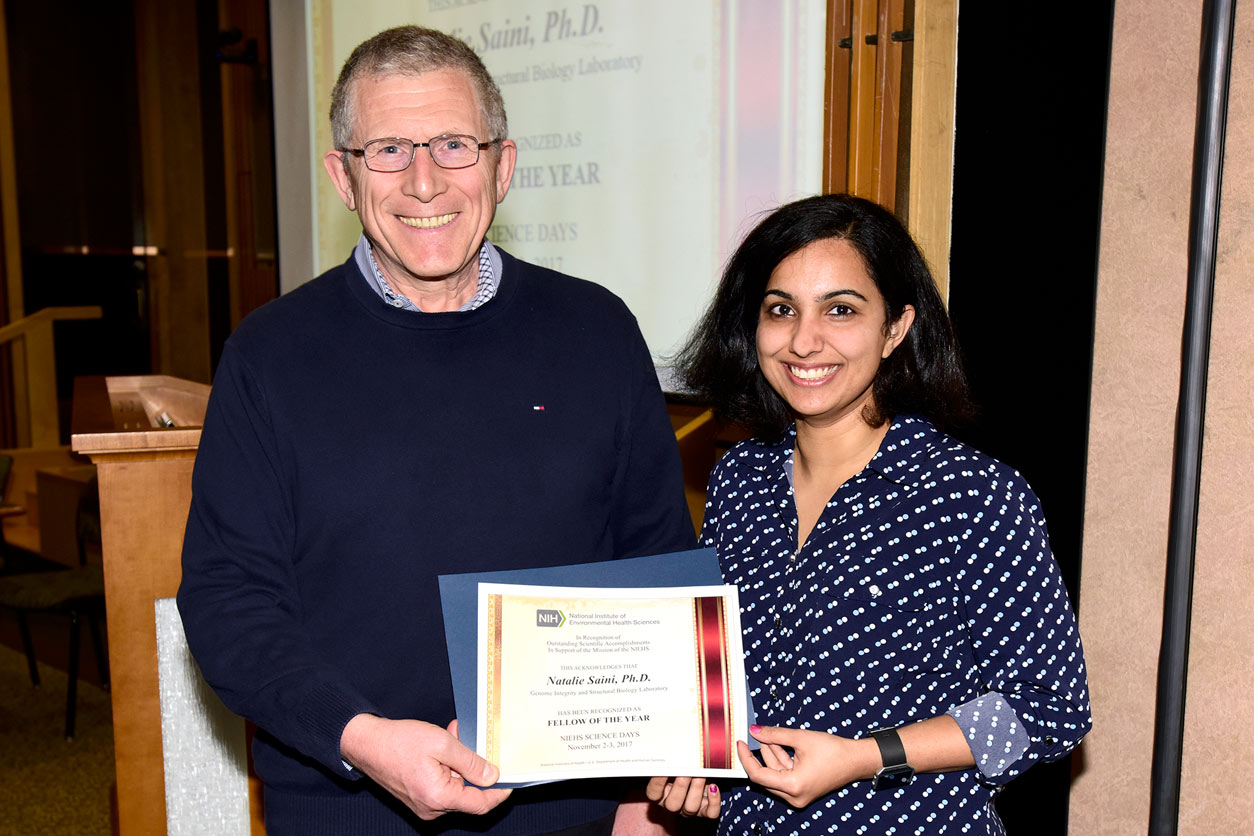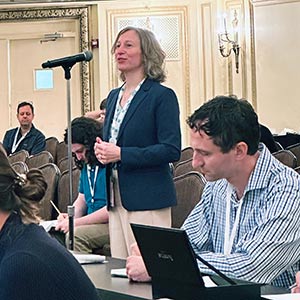For the first time, scientists have measured the different types of DNA changes that occur across all genes in human skin cells. In a paper published Jan. 14 in the journal PLOS Genetics, a team of researchers led by Dmitry Gordenin, Ph.D., reported that even skin normally shielded from the sun had mutations from ultraviolet (UV) light. Gordenin leads the NIEHS Mechanisms of Genome Dynamics Group.
The DNA in our skin is damaged by factors both inside and outside the body, resulting in changes that may lead to cancer. A major external source of these mutations is UV light. Internal sources include byproducts of cellular metabolism — such as free radicals or addition of methyl groups to DNA, called DNA methylation — and errors in DNA copying during cell division.
These mutation-causing mechanisms are well known, but until now, no one had accurately quantified the relative contributions from each source.
 Gordenin, left, and Saini posed when she was voted 2017 NIEHS Fellow of the Year. She is now on faculty at the Medical University of South Carolina. (Photo courtesy of Steve McCaw / NIEHS)
Gordenin, left, and Saini posed when she was voted 2017 NIEHS Fellow of the Year. She is now on faculty at the Medical University of South Carolina. (Photo courtesy of Steve McCaw / NIEHS)Cells’ entire genome sequenced
In their new paper, lead author Natalie Saini, Ph.D., a former postdoctoral fellow in Gordenin’s group, and her colleagues sequenced the entire genomes of skin cells obtained through the NIEHS Environmental Polymorphisms Registry(https://dnaregistry.niehs.nih.gov/) (see sidebar). The group, large enough to ensure statistically significant results, included Black and white volunteers ranging in age from 25 to 79.
By measuring the amount of each type of mutation in the donors’ cells, the team made several discoveries. Notably, genomic changes from metabolic byproducts were shown to accumulate as a person gets older. In contrast, the amount of genomic changes from UV damage was not related to age.
Moreover, UV-light damage turned out to be common in skin normally shielded from the sun. “We were surprised that we could quantify UV-induced mutations in skin biopsies obtained from the hip,” said Saini. “This tells us that even intermittent sun-exposure in otherwise sun-shielded skin can lead to a burst of DNA damage and mutation accumulation in our cells.”
The new study is the first to confirm that across the entire genome, the UV mutation load was less prevalent in Black donors than white donors, Gordenin noted. Higher levels of the skin pigment melanin may explain that observation, as well as the corresponding lower rate of skin cancer among the Black population compared with whites.
Baseline for future research
“The new study … establishes the normal range of somatic genomic changes across a wide range of ages and of different races, providing a baseline for future research,” wrote the authors. Somatic mutations occur in cells other than sperm and egg, or germ cells, so they are passed on through cell division to future cells of the body, but not to offspring.
The authors noted that prior attempts to measure the range and complete spectrum of genome changes in healthy skin experienced technical or biological limitations. Gordenin’s team overcame those challenges in two ways. First, their strategy for establishing clones of the original single cells prevented accumulation of so-called mutational noise, or mutations that occur after biopsy, during the cell culture process.
Second, results of earlier studies pointed the researchers to a specific short, recurring pattern, or motif, in the DNA sequence that they knew to be involved in a key mutagenic mechanism.
Rooted in need for normal
“We were learning that tumor cells carry a large number of mutations and their genomes are highly unstable,” Saini explained. “However, we did not have a [so-called] normal to compare such tumors to. So we set out to identify the total number of mutations in a single cell of a health person’s skin.”
The new study extends an earlier study that quantified mutations in skin cells from two people. “We were able to expand our cohort and analyze how sex and race-based differences further alter mutation loads in individuals,” said Saini.
Citations:
Saini N, Giacobone CK, Klimczak LJ, Papas BN, Burkholder AB, Li J-L, Fargo DC, Bai R, Garrish K, Innes CL, Schurman SH, Gordenin DA. 2021. UV-exposure, endogenous DNA damage, and DNA replication errors shape the spectra of genome changes in human skin. PLoS Genet 17(1):e1009302.
Saini N, Roberts SA, Klimczak LJ, Chan K, Grimm SA, Dai S, Fargo DC, Boyer JC, Kaufmann WK, Taylor JA, Lee E, Cortes-Ciriano I, Park PJ, Schurman SH, Malc EP, Mieczkowski PA, Gordenin DA. 2016. The impact of environmental and endogenous damage on somatic mutation load in human skin fibroblasts. PLoS Genet 12(10):e1006385.
(This article is based on a press release from PLOS Genetics.)









